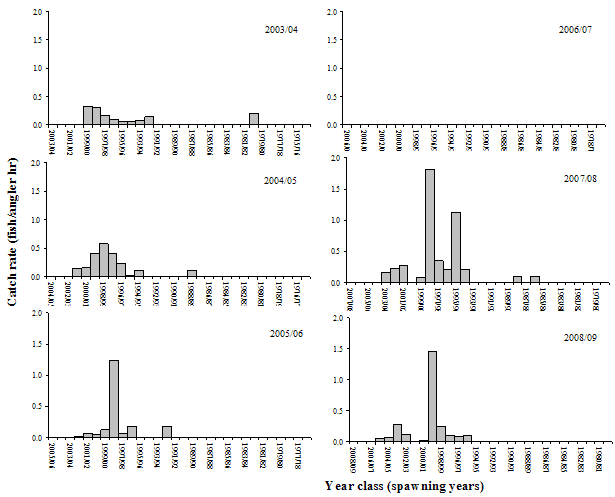Detecting the impacts of recent changes in fishing pressure on key recreational fish stocks in Mallacoota Inlet and Lake Tyers

Recreational Fishing Grant Program - Research report
Project number: R/05/06/06
JUNE 2010
Simon Conron, Natalie Bridge and Thérèse Stokie.
Preferred way to cite this publication: Conron, S., Bridge, N.F. and Stokie, T.K. (2010). Detecting the impacts of recent changes in fishing pressure on key recreational fish stocks in Mallacoota Inlet and Lake Tyers. Recreational Fishing Grant Program - Research report.
ISSN: 1833-3478
ISBN: 978-1-74264-238-3 (print)
978-1-74264-239-0 (online)
Table of Contents
Executive Summary
Introduction
Purpose of this report
Methods
Determining the impacts of changes in the levels of fishing pressure
Data collection
Angler Fishing Diary Program
Survey of recreational anglers
Data analysis
Results
Determining the impacts of changes in the levels of fishing pressure
Angler perceptions of black bream and dusky flathead populations
Numbers and size of black bream
Numbers and size of dusky flathead
Discussion
Conclusions
Acknowledgements
References
Appendix 1
Executive Summary
In 2002 the Victorian Government announced its intention to close the Mallacoota Inlet and Lake Tyers estuaries to commercial fishing (other than for eels and bait) and to declare these waters as Fisheries Reserves to be managed primarily for the purpose of maintaining or enhancing recreational fishing opportunities. Commercial fishing was removed from these estuaries in April 2003 and the Fisheries Reserves were declared in January 2004. Fishery management plans were subsequently developed and implemented for these two Reserves.
To assess the possible effects that the closure of commercial fishing had on the availability of key recreational fish stocks in Mallacoota Inlet and Lake Tyers, and on the perceived quality of recreational fishing, an angler diary program and angler satisfaction survey were undertaken.
Changes in the levels of fishing pressure on black bream stocks following the removal of commercial fishing were investigated using data collected by volunteer angler diarists targeting black bream in Mallacoota Inlet and Lake Tyers. Total mortality rate estimates of legal-sized black bream, from age-based cohort analysis of catch data, indicated that the annual mortality declined from 57% to 31-36% following the removal of commercial fishing in Mallacoota Inlet. Data collected in Lake Tyers after the removal of commercial fishing indicated an annual mortality rate of 24%. A longer time series of catch rate data for recruited black bream would improve the confidence in total mortality estimates.
Anglers surveyed in Mallacoota Inlet and Lake Tyers after the removal of commercial fishing were generally more satisfied with both black bream and dusky flathead fishing in these estuaries compared with anglers surveyed in the Gippsland Lakes, where commercial fishing continues.
The majority of anglers fishing in Mallacoota Inlet and Lake Tyers believed that there were more or about the same number of black bream and dusky flathead and that the black bream were of a similar size or bigger during the 4-year period following the removal of commercial fishing in Mallacoota Inlet and Lake Tyers compared with the 4 years prior (1999 to mid 2003). They attributed this increase to the removal of commercial fishing in these estuaries.
In contrast, anglers surveyed in the Gippsland Lakes felt there were less black bream and that they were of a smaller size after mid 2003, compared with the 4 years prior. Many (36%) attributed this perceived decline to increased fishing pressure from both the recreational and commercial fishery. A further 24% of anglers credited the perceived decline specifically to commercial fishing. Environmental factors associated with spawning success and fishing regulations were also provided as reasons for the perceived decline.
More anglers fishing in Mallacoota Inlet and Lake Tyers were satisfied (44-58%) rather than dissatisfied (18-32%) with the quality of black bream and dusky flathead fishing in the 12 months prior to being interviewed.
Opinion surveys of recreational fishers and angler fishing diary programs are valuable tools for collecting information on changes in fisheries and the fish stocks on which they depend.
Introduction
Prior to the November 2002 State election, the Victorian Government indicated its commitment to improving recreational fishing opportunities by proposing the establishment of fisheries reserves in three Gippsland estuaries: Anderson Inlet, Mallacoota Inlet and Lake Tyers. The proposals for Mallacoota Inlet and Lake Tyers included the removal of commercial fishing, other than fishing for eels and bait (DPI 2006, 2007).
Public submissions received between October and December 2002 indicated there was high public support for these proposals. Mallacoota Inlet and Lake Tyers were declared as Fisheries Reserves on 22 January 2004, to be managed primarily for the purpose of maintaining or enhancing recreational fishing opportunities (DPI 2006, 2007).
There was a long history of commercial fishing in both Mallacoota Inlet and Lake Tyers, commencing in the late 1880s and continuing until April 2003 when the remaining licences were cancelled. Commercial fishing for eel and bait fish (primarily targeting prawn and bass yabbies in Mallacoota Inlet and prawn, shrimp and sandworm in Lake Tyers) is still permitted (DPI 2006, 2007).
Black bream and luderick were the main target species in the Mallacoota Inlet commercial fishery, while black bream was the largest and most valuable component of commercial catches in Lake Tyers (MacDonald 1997). From 1978 to 2003, black bream contributed 19% and 38% of the total commercial catch in Mallacoota Inlet and Lake Tyers, respectively. In comparison, commercial catches of dusky flathead were generally small and incidental in the Mallacoota Inlet (2%) and Lake Tyers (3%) (DPI 2006, 2007).
This study evaluates the effect the removal of the commercial fishing in Mallacoota Inlet and Lake Tyers had on the availability of key recreational fish stocks, and on the perceived quality of recreational fishing.
If the removal of commercial fishing resulted in a reduction in fishing pressure (hence, mortality) on a fish population, where constant recruitment levels are maintained, an increase in both catch rates and the average length of fish for those still participating in the fishery (i.e. recreational anglers) would be expected.
As a key target species in both the recreational and commercial fisheries, black bream was the species most likely to be influenced by the removal of commercial fishing in Mallacoota Inlet and Lake Tyers.
Assessing angler opinions of fish stocks gives important insights into the perceived catch benefits and quality of fishing in Mallacoota Inlet and Lake Tyers following the removal of commercial fishing.
Funding was sought from the Recreational Fishing Licence Trust Fund and Fisheries Victoria to conduct an angler diary program and access point angler surveys in Mallacoota Inlet and Lake Tyers to provide information for this purpose.
Purpose of this report
This report presents recreational catch and effort data obtained from angler diary programs and access point angler surveys in Mallacoota Inlet and Lake Tyers to:
- Determine whether changes in the levels of fishing pressure (and therefore mortality rates) on black bream in Mallacoota Inlet and Lake Tyers, could be detected following the removal of commercial fishing in 2003
- Determine levels of angler fishing satisfaction and perceptions of fishing quality before and after the removal of commercial fishing in Mallacoota Inlet and Lake Tyers and compare these results with similar data from the Gippsland Lakes where commercial fishing continues.
Methods
Determining the impacts of changes in the levels of fishing pressure
Previous studies of recreational fisheries in Mallacoota Inlet and Lakes Tyers have indicated that black bream and dusky flathead are the most commonly caught species by recreational fishers in these estuaries (Conron et al. 2010, Hall et al. 1985a, 1985b, Kent et al. 2010, Stokie et al. 2010).
A time series of catch data from an angler diary program was used to determine whether changes in fishing pressure on black bream could be measured following the removal of commercial fishing.
Many factors in the environment as well as fishing pressure act to reduce the chances of survival of individual fish in a population. The total mortality rate (Z) of a fish population is the sum of the fishing mortality rate (F) and natural mortality rate (M).
Where catch and age-composition data exist, total mortality rates were estimated by plotting the natural logarithms of catch rates of surviving fish cohorts over successive years as a catch curve (Deriso et al.1985). Regression analysis of log-transformed combined cohort catch rate data was undertaken using Genstat (2009).
Data collection
ANGLER FISHING DIARY PROGRAM
Catch rate, size and age composition data were provided through an angler fishing diary program specifically set up to monitor the abundance of the size and year-classes of black bream populations in small estuaries (Conron 2004, Bridge and Conron 2010, Conron et al. 2010).
Participating anglers altered their fishing techniques in order to catch the largest possible size range of black bream. A detailed diary was used to record the time spent fishing, fish lengths and bait and hook sizes used. Anglers also removed the otoliths (ear bones) from a sample of their bream catch for the purposes of ageing.
These anglers were called 'research anglers' as they were participating in an instructed fish sampling program.
The age of fish was determined by counting growth rings in otoliths. Otoliths were prepared and aged following standard procedures, where one year of growth consists of a translucent and subsequent opaque zone (Morison et al. 1998). Otolith samples were used to identify the age and spawning year (i.e. year-class) of fish.
Research anglers began recording their fishing trips in Mallacoota Inlet in 1997 and Lake Tyers in 2001. Otolith collection commenced the following year (i.e. in 1998 for Mallacoota Inlet and in 2002 for Lakes Tyers).
SURVEY OF RECREATIONAL ANGLERS
Angler surveys were conducted in Mallacoota Inlet, Lake Tyers and Gippsland Lakes from January to August 2007. Anglers were asked if they had been previously interviewed, to ensure they were only surveyed once.
Anglers were also asked about the quality of fishing in the previous 12 months. For anglers who had fished in previous years, their opinion was sought on how the number and size of black bream and dusky flathead caught since mid 2003 compared with fish caught in the 4 years prior.
Data analysis
Catch data from angler fishing diaries were entered into an Access database. A time series of catch rate information was generated for black bream in Mallacoota Inlet and Lake Tyers.
Mean catch rates were calculated for black bream from targeted fishing trips. The catch rates of particular age classes of black bream in Mallacoota Inlet and Lake Tyers were determined by ageing otoliths and then applying the resulting age-length distribution to annual catch rates for different black bream length classes.
Total mortality estimates were based on the rate of decline of catch rates of particular age cohorts of black bream that had recruited to the fishery (i.e. above the Legal Minimum Length, LML, of 26 cm Total Length, TL). Independently derived selectivity functions (Conron et al. 2009) were used to correct black bream catch rate data for length-dependant selectivity of fishing gear (hook size) and variable hook effort. By assuming that natural mortality and the catchability of the recruited bream populations were constant, a change in total mortality was considered a reflection of changes in fishing mortality.
Angler survey responses were compared statistically between estuaries using a two-sample binomial test (Genstat 2009).
Results presented by financial year were considered the best representation of a single black bream fishing season.
Results
Determining the impacts of changes in the levels of fishing pressure
Research anglers fishing in Mallacoota Inlet and Lake Tyers caught 3938 black bream during 471 fishing trips (Table 1). A total of 2455 black bream otoliths were aged.
Catch rates of black bream year-classes in Mallacoota Inlet and Lake Tyers are presented by financial year, in Appendix 1.
Preliminary analysis of catch data in Mallacoota Inlet and Lake Tyers was used to identify the following abundant year-class groups:
- Mallacoota Inlet 1992/93, 1993/94 and 1994/95
- Mallacoota Inlet 1997/98 and 1998/99
- Lake Tyers 1997/98, 1998/99 and 1999/00.
The decline in catch rates for these year-class groups was monitored over time (Figures 1-3). Estimates of instantaneous total mortality (Z) were made after year-classes had recruited to the fishery (i.e. were above the LML).
The decline in the combined catch rates of Mallacoota Inlet black bream year-classes (1992/93, 1993/94 and 1994/95) was monitored over a 12-year period (Table 1). Age at length data suggest these fish had recruited to the fishery by 2000/01. Following the removal of commercial fishing, Z decreased from 0.84 (2000/01-2002/03) to 0.37 (2003/04-2008/09). Annual mortality declined from 57% to 31% over the same time period (Table 2).
Monitoring of the remaining year-class groups (Mallacoota Inlet 1997/98-1998/99, Lake Tyers 1997/98-1999/00) commenced after the removal of commercial fishing. These black bream had recruited to the fishery in 2007/08.
From 2007/08 to 2008/09, the annual mortality of combined year-classes in Mallacoota Inlet (1997/98-1998/99) was 36% (Table 2). Estimates of annual mortality, after the removal of commercial fishing, were similar for both year-class groups in Mallacoota Inlet (36% and 31%) (Table 2).
From 2007/08 to 2008/09, the annual mortality of combined year-classes in Lake Tyers (1997/98-1999/00) was 24% (Table 2).
Table 1. Summary of fishing effort, catches and ageing of black bream reported in Mallacoota Inlet and Lake Tyers.
| Estuary | Time period | Research anglers (n) | Fishing trips (n) | Black bream caught (n) | Fish aged (n) |
|---|---|---|---|---|---|
Mallacoota Inlet | Sept 1997 - Dec 2009 | 2 | 181 | 2000 | 1912 |
Lake Tyers | Oct 2004 - Mar 2009 | 1 | 290 | 1938 | 543 |
Figure 1. Mean catch rates of three successive year-classes spawned in 1992/93, 1993/94 and 1994/95 in Mallacoota Inlet. Mallacoota Inlet was closed to commercial fishing mid 2003, indicated by dashed line.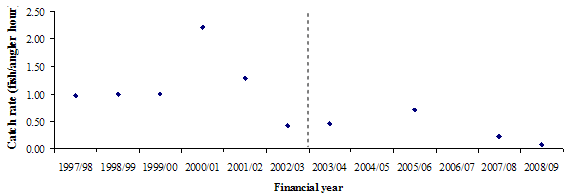
Figure 2. Mean catch rates of two successive year-classes spawned in 1997/98 and 1998/99 in Mallacoota Inlet.
N.B. Mallacoota Inlet was closed to commercial fishing mid 2003.
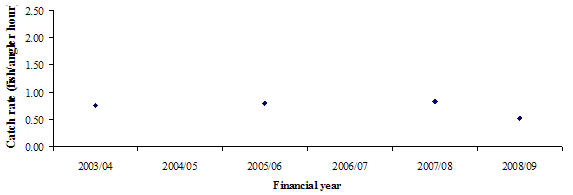
Figure 3. Mean catch rates of three successive year-classes spawned in 1997/98, 1998/99 and 1999/00 in Lake Tyers.
N.B. Lake Tyers was closed to commercial fishing mid 2003.
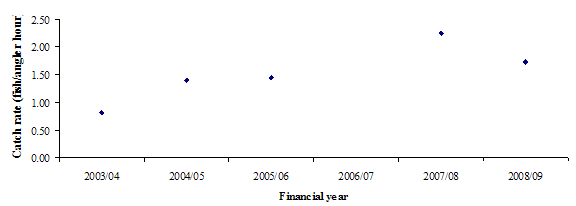
Table 2. Estimates of the instantaneous total mortality rate (Z), annual survival and mortality of black bream year-classes in Mallacoota Inlet and Lake Tyers.
Estuary | Year-classes | Time period | Z | ZSE | Annual survival* | Annual mortality# | R2 |
Mallacoota Inlet | 1992/93-1994/95 | 2000/01-2002/03 | 0.84 | 0.17 | 43% | 57% | 0.92 |
2003/04-2008/09 | 0.37 | 0.19 | 69% | 31% | 0.46 | ||
1997/98-1998/99 | 2007/08-2008/09 | 0.45** | N/A | 64% | 36% | N/A | |
Lake Tyers | 1997/98-1999/00 | 2007/08-2008/09 | 0.27** | N/A | 76% | 24% | N/A |
*Survival (%) = 100 exp [-Z]
#Mortality (%) = 100 (1 -exp [-Z])
**Estimates were made on two years of data (2007/08-2008/09), when black bream had recruited to the fishery.
Angler perceptions of black bream and dusky flathead populations
Surveys were conducted with anglers fishing in Mallacoota Inlet (n=357), Lake Tyers (n=157) and Gippsland Lakes (n=558) during 2007.
Angler satisfaction levels for bream fishing in the 12 months prior to being interviewed were similar in Mallacoota Inlet and Lake Tyers (Figure 4a). More anglers were satisfied (i.e. very satisfied or quite satisfied, 44-46%) than not satisfied (i.e. not very satisfied or not at all satisfied, 20-32%); 15-17% were very satisfied (Figure 4a). In comparison, more anglers interviewed in Gippsland Lakes were unsatisfied with bream fishing (37%) compared with those satisfied (33%); few anglers were very satisfied (5%) (Figure 4a).
The majority of anglers surveyed were satisfied with dusky flathead fishing in Mallacoota Inlet (58%) and Lake Tyers (53%); 35% of anglers in Mallacoota Inlet were very satisfied. Few anglers (3-4%) were not satisfied at all (Figure 4b). A similar proportion of Gippsland Lakes anglers were satisfied (26%) and not satisfied (27%) with dusky flathead fishing; few anglers were very satisfied (4%) (Figure 4b).
Figure 4. Angler satisfactions level of a) black bream and b) dusky flathead fishing in the 12 months prior to being interviewed in Lake Tyers (n=117), Mallacoota Inlet (n=275) and Gippsland Lakes (n=420).
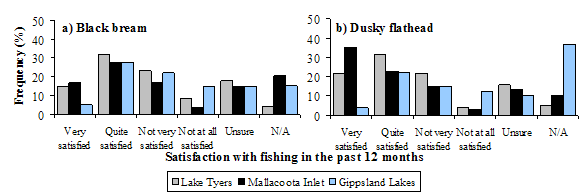
NUMBERS AND SIZE OF BLACK BREAM
In Lake Tyers over a third of anglers (38%) thought the numbers of black bream had increased since mid 2003, 28% thought numbers were about the same while nearly a quarter of anglers thought there were less bream after mid 2003 in comparison to the four years prior (1999 to mid 2003) (Figure 5).
Almost a third of anglers surveyed in Mallacoota Inlet thought that the numbers of black bream had increased (30%) since mid 2003. Few anglers thought there were less bream (7%) while many anglers were unsure (27%) (Figure 5).
Significantly more Gippsland Lake anglers believed there were less black bream after mid 2003 (61%) compared with anglers in Mallacoota Inlet (7%, p=0.003) and Lake Tyers (24%, p<0.001) (Figure 5).
Between 21% and 31% of all anglers surveyed believed the size of black bream increased after mid 2003, while 25% to 36% thought they were about the same size. A higher proportion of anglers felt that black bream were smaller after mid 2003 in Gippsland Lakes (40%) than in Mallacoota Inlet (8%, p<0.001) and Lake Tyers (24%, p=0.014) (Figure 6).
Figure 5. Angler opinion on the number of black bream caught from mid 2003 to 2007 compared with 1999 to mid 2003 in Lake Tyers (n=67), Mallacoota Inlet (n=123) and Gippsland Lakes (n=254).
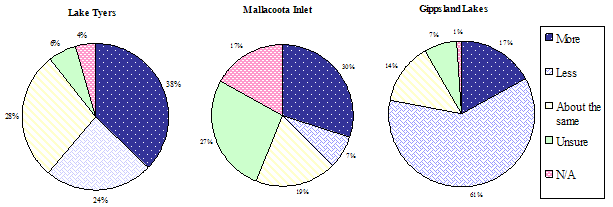
Figure 6. Angler opinion on the size of black bream caught from mid 2003 to 2007 compared with 1999 to mid 2003 in Lake Tyers (n=67), Mallacoota Inlet (n=123) and Gippsland Lakes (n=254).

NUMBERS AND SIZE OF DUSKY FLATHEAD
Many anglers fishing in Mallacoota Inlet (36%) and Lake Tyers (47%) felt there were more dusky flathead after mid 2003 when compared with the four years prior (Figure 7). Nearly a quarter of anglers thought flathead numbers were about the same.
A higher proportion of anglers believed there were less dusky flathead now than prior to mid 2003 in Gippsland Lakes (29%) and Lake Tyers (20%) when compared with Mallacoota Inlet (9%, p<0.001 and p=0.044, respectively).
More anglers surveyed in Lake Tyers (43%) believed the size of dusky flathead were bigger after mid 2003 when compared statistically with anglers surveyed in Mallacoota Inlet (22%, p=0.002) and Gippsland Lakes (20%, p<0.001) (Figure 8). Many anglers surveyed in the three estuaries believed dusky flathead were about the same size over the two time periods (20-34%), while 12-21% believed they were smaller now than in the four years from 1999 to mid 2003 (Figure 8).
Approximately a quarter of anglers surveyed in Mallacoota Inlet (24-27%) were unsure about changes in numbers and size of dusky flathead, while 24% to 27% of anglers in Gippsland Lakes felt the question was not applicable.
Figure 7. Angler opinion on the number of dusky flathead caught from mid 2003 to 2007 compared with 1999 to mid 2003 in Lake Tyers (n=67), Mallacoota Inlet (n=123) and Gippsland Lakes (n=254).
N.B. Mallacoota Inlet and Lake Tyers were closed to commercial fishing mid 2003.
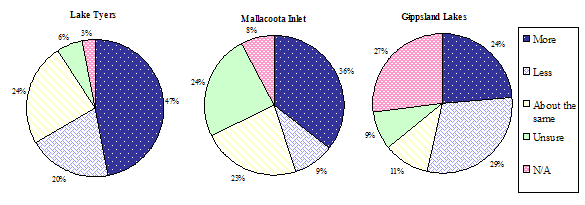
Figure 8. Angler opinion on the size of dusky flathead caught from mid 2003 to 2007 compared with 1999 to mid 2003 in Lake Tyers (n=67), Mallacoota Inlet (n=123) and Gippsland Lakes (n=254).
N.B. Mallacoota Inlet and Lake Tyers were closed to commercial fishing mid 2003.
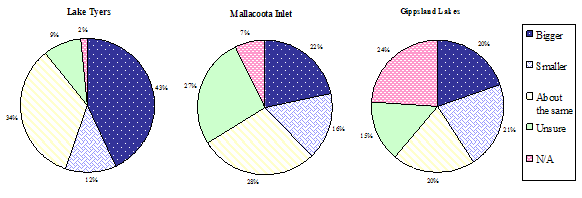
Discussion
Commercial fishing activities have been removed from a number of estuaries in Victoria and elsewhere in recent years. In many cases, the stated objective of these closures has been to improve the quality of recreational fishing (DPI 2006, 2007, Steffe et al. 2005).
This report quantifies the benefits of reduced fishing pressure on key fish stocks. This was achieved by monitoring angler catch rates of legal-sized black bream before and after the removal of commercial fishing in 2003, as well as assessing angler perceptions relating to any improvement in the quality of catches.
Changes in the total mortality of black bream year-classes were used to measure changes in the fishing pressure on black bream stocks. The annual mortality of black bream decreased from 57% (prior to mid 2003) to 31% and 36% following the removal of commercial fishing. Assuming constant natural mortality and catchability, this decline in total mortality indicates there has been a large reduction in fishing pressure, resulting from the removal of commercial fishing in Mallacoota Inlet.
The total mortality rate of black bream in Lake Tyers could not be estimated prior to the removal of commercial fishing due to a lack of appropriate data. The annual mortality of black bream in Lake Tyers after the removal of commercial fishing (24%) was lower than in Mallacoota Inlet (31% and 36%) and Sydenham Inlet (36%, Conron 2004). This suggests the impact of recreational fishing on black bream stocks is of a similar order of magnitude in these estuaries.
A longer time series of catch rate data for recruited black bream would improve the confidence in total mortality estimates. The angler fishing diary programs in Mallacoota Inlet and Lake Tyers are currently ongoing. This will allow monitoring of black bream year-classes and estimation of total mortality rates into the future.
Anglers surveyed in Mallacoota Inlet and Lake Tyers after the removal of commercial fishing were generally more satisfied with both black bream and dusky flathead fishing in these estuaries compared with anglers surveyed in the Gippsland Lakes, where commercial fishing continues.
The majority of anglers fishing in Mallacoota Inlet and Lake Tyers believed that there were more or about the same number of black bream and dusky flathead and that the black bream were of a similar size or bigger from mid 2003 to 2007 compared with 1999 to mid 2003. In contrast, anglers surveyed in the Gippsland Lakes felt there were less black bream and that they were smaller after mid 2003 compared with the period 1999 to mid 2003.
The majority of anglers in Mallacoota Inlet and Lake Tyers who thought there were more black bream after mid 2003 attributed the increase to the removal of commercial fishing in these estuaries. Many anglers (36%) in the Gippsland Lakes attributed the perceived decline in black bream to increased fishing pressure from both the recreational and commercial fishery. A further 24% of anglers attributed the perceived decline specifically to commercial fishing. Environmental factors associated with spawning success and fishing regulations were also provided as reasons for the perceived decline.
Recruitment and year-class strength of black bream was highly variable and differed between estuaries. Jenkins et al. (in prep) showed most recruitment variability of black bream in the Gippsland Lakes can be explained by water column stratification with additional variability explained by freshwater flow. In recent years, production of black bream in the Gippsland Lakes has been restricted by a reduction in freshwater flows.
From 1999 to mid 2003, the black bream population in Gippsland Lakes was dominated by fish spawned in 1989 (10-14 years of age) and 1995 (4-8 years of age). Between 2003 and 2007, these year-classes contributed far less to the population, which was now dominated by younger and smaller fish spawned in 2001 (2-6 years of age) and 2003 (0-4 years of age).
In 2003, the LML of black bream was increased from 26 to 28 cm TL in the Gippsland Lakes. Although fishing pressure by both commercial and recreational fishers has not changed greatly since 2003, the increase in the LML coupled with the difference in the age structure of the population and reduced production of black bream due to freshwater flows, has led to recreational anglers catching fewer and smaller black bream in comparison with the four years prior, 1999 to mid 2003.
More anglers fishing in Mallacoota Inlet and Lake Tyers were satisfied (44-58%) rather than dissatisfied (18-32%) with the quality of black bream and dusky flathead fishing in the 12 months prior to being interviewed.
Using catch data collected as part of an on-site angler catch survey, Steffe et al. (2005) showed that catch rates and the size of some species (that were previously harvested by the commercial fishery) increased after the closure of commercial fishing in Lake Macquarie, New South Wales. These findings were consistent with a decline in fishing mortality.
Similar comparisons were not possible for black bream in Mallacoota Inlet and Lake Tyers as there was no recreational fishery catch data collected prior to the closure of the commercial fishery for comparison.
A satisfaction survey conducted in Mallacoota Inlet between December 2007 and October 2008 showed the majority of boat- (84%) and shore-based anglers (76%) were satisfied with the overall quality of fishing in Mallacoota Inlet in the previous 12 months (Kent et al. 2010).
Opinion surveys of recreational fishers and angler fishing diary programs are valuable tools for collecting information on changes in fisheries and the fish stocks on which they depend. The recreational fisheries and abundance of key recreational species in Mallacoota Inlet and Lake Tyers will continue to be monitored though an angler diary program (ongoing) and on-site surveys (conducted every 5 years).
Conclusions
Changes in the total mortality of black bream stocks (an indicator of fishing pressure) following the removal of commercial fishing in Mallacoota Inlet and Lake Tyers in 2003 were investigated using data collected by volunteer angler diarists targeting black bream.
Total mortality rate estimates of legal-sized black bream, from age-based cohort analysis of catch data, indicated that the annual mortality declined from 57% to 31-36% following the removal of commercial fishing in Mallacoota Inlet. Data collected in Lake Tyers after the removal of commercial fishing indicated an annual mortality rate of 24%.
A longer time series of catch rate data for black bream would improve the confidence in total mortality estimates.
Anglers surveyed in Mallacoota Inlet and Lake Tyers after the removal of commercial fishing were generally more satisfied with both black bream and dusky flathead fishing in these estuaries compared with anglers surveyed in the Gippsland Lakes, where commercial fishing continues.
The majority of anglers fishing in Mallacoota Inlet and Lake Tyers believed that there were more or about the same number of black bream and dusky flathead and that the black bream were of a similar size or bigger during the 4-year period following the removal of commercial fishing in Mallacoota Inlet and Lake Tyers compared with the 4 years prior (1999 to mid 2003). They attributed this increase to the removal of commercial fishing in these estuaries
In contrast, anglers surveyed in the Gippsland Lakes felt there were less black bream and that they were of a smaller size after mid 2003, compared with the 4 years prior. Many (36%) attributed this perceived decline to increased fishing pressure from both the recreational and commercial fishery. A further 24% of anglers credited the perceived decline specifically to commercial fishing. Environmental factors associated with spawning success and fishing regulations were also provided as reasons for the perceived decline.
More anglers fishing in Mallacoota Inlet and Lake Tyers were satisfied (44-58%) rather than dissatisfied (18-32%) with the quality of black bream and dusky flathead fishing in the 12 months prior to being interviewed.
Acknowledgements
This project was funded by the Recreational Fishing Licence Trust Fund using Recreational Fishing Licence fees and Fisheries Victoria (Project numbers R/05/06/06).
We wish to express our thanks to the many recreational anglers who have, over the years, freely provided us with information needed for this study.
Special thanks go to the research anglers John Harrison, Frank Richards and John Wood.
We would also like to thank Di Crookes, John Minehan, and staff from Wildlife Unlimited including Fiona Stevens, Heidi Murphy and Jim and Jenny Reside for their efforts in interviewing several thousand recreational anglers as part of the angler survey. We also like to acknowledge the efforts of David Bull who assisted with the running of survey work at Mallacoota Inlet.
Thanks to Pam Oliveiro, Katrina Halse, Vicki Nicholas and Tina Whillock for data editing and entry.
Thanks to Laurie West (Kewagama Research P/L) for designing the angler survey questionnaire.
Thanks to Khageswor Giri for his assistance with statistical analyses and Dr Vladimir Troynikov for advice on catch curve analysis.
Thanks to Karina Ryan and Dr Murray MacDonald for editorial advice on this report. Thanks to Dr James Andrews and Jon Presser for their comments on this report.
References
Bridge, N.F. and Conron, S.D. (2010). State-wide Angler Fishing Diary Program. Recreational Fishing Grant Program Final Report Project Number: R/03/04/05. Department of Primary Industries, Victoria.
Conron, S.D. (2004). Recreational fishery management controls of commercially important species. Project No. 98/146. Primary Industries Research Victoria, Department of Primary Industries, Victoria.
Conron, S. D., Grixti, D and Morison, A.K. (2009). Survival of snapper and black bream released by recreational hook-and-line fishers in sheltered coastal temperate ecosystems. Project No. 2003/074. Primary Industries Research Victoria, Marine and Freshwater Systems, Department of Primary Industries, Queenscliff, Victoria, 3225.
Conron, S., Bridge, N.F., Grixti, D., Ward, M. and Stokie, T.K. (2010). Angler diary monitoring or recreational target fish stocks in selected Victorian estuaries. Recreational Fishing Grant Program Final Report. Department of Primary Industries, Victoria.
Department of Primary Industries (2006). Mallacoota Inlet Fisheries Reserve Management Plan 2006. Fisheries Victoria Management Report Series No. 36.
Department of Primary Industries (2007). Lake Tyers Fisheries Reserve Management Plan 2007. Fisheries Victoria Management Report Series No. 43.
Deriso, R.B., Quinn II, T.J., Neal, P.R. (1985). Catch-age analysis with auxiliary information. Can. J. Fish. Aquat. Sci. 42, 815-824.
Genstat (2009). GenStat Release 12.1 PC/Windows XP. Copyright 2009, VSN International Ltd.
Hall, D.N., MacDonald, C.M. and Kearney, J.D. (1985a). A survey of recreational fishing in Mallacoota inlet, Victoria. Fish. Wild. Serv., Victoria, Mar. Fish. Rep. No 5.
Hall, D.N. and MacDonald, C.M. (1985b). A survey of recreational fishing and aquatic resources use in Lake Tyers, Gippsland, Fisheries and Wildlife Service, Victoria. Marine Fish Report No. 6.
Jenkins, G.P., Conron, S. and Morison, A.K. (in prep.). Highly variable recruitment in an estuarine-dependent fish is determined by salinity stratification and freshwater flow: implications of climate change.
Kent, J., Hindell, J. and Conron, S. (2010). Recreational fishery monitoring and fish habitat research needed to facilitate management of the Mallacoota Inlet Fisheries Reserve. Recreational Fisheries Grant Program Final Report. Department of Primary Industries, Victoria.
MacDonald, C.M. (1997). Lake Tyers fin fisheries 1994, Fisheries Assessment Report No. 1. Fisheries Victoria, East Melbourne.
MacDonald, C.M., Winstanley, R.H. and Hall, D.N. (1997). Mallacoota Inlet commercial fin fish fishery 1994. Fisheries Assessment Report No. 2. Fisheries Victoria, East Melbourne.
Morison, A.K., Robertson, S.G. and Smith, D.C. (1998). An integrated system for production fish ageing: Image analysis and quality assurance. North American Journal of Fisheries Management 18, 587-598.
Steffe, A.S., Murphy, J.J. Chapman, D.J. and Gray, C.C. (2005). An assessment of changes in the daytime recreational fishery of Lake Macquarie following the establishment of a 'Recreational Fishing Haven'. NSW Department of Primary Industries. Fisheries final report series no. 79, 103 pp. Sep 2005.
Stokie, T.K., Bridge, N.F., MacDonald, M. and Conron, S. (2010). Evaluation of changes to dusky flathead catch limits in Mallacoota Inlet. Recreational Fishing Grant Program - Research report.
Appendix 1
Figure 9. Catch rates of individual black bream year-classes sampled in Mallacoota Inlet from 1997/98 to 2008/09.
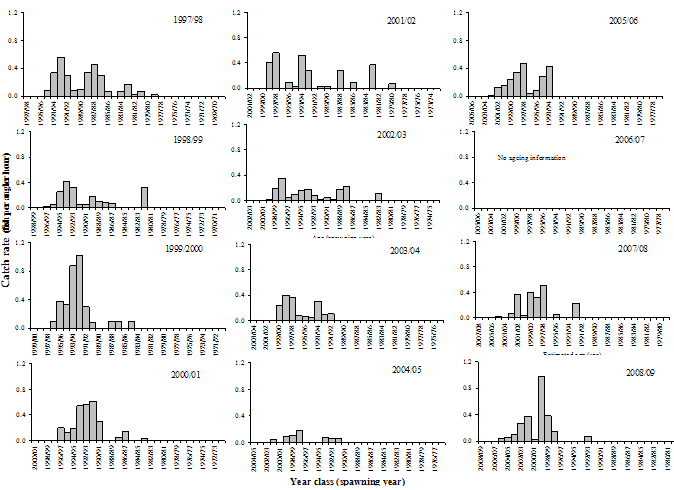
Figure 10. Catch rates of individual black bream year-classes sampled in Lake Tyers from 2003/04 to 2008/09.
